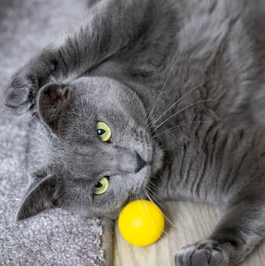
Playtime for Cats: The Importance of Regular Exercise and Mental Stimulation
Share
Physical Exercise
Cats are natural hunters and have a natural instinct to stalk, chase, and pounce. Regular playtime allows them to engage in these behaviors, providing the physical exercise they need to maintain a healthy weight and muscle tone. Active play sessions that involve toys, such as interactive wands or laser pointers, can encourage your cat to jump, run, and engage in aerobic activities. Physical exercise not only helps prevent obesity but also promotes cardiovascular health and overall fitness.

Mental Stimulation
Playtime is not only about physical activity but also about mental stimulation. Engaging your cat in interactive play helps keep their minds sharp and active. The anticipation, problem-solving, and strategizing involved in play sessions simulate the hunting experience, providing intellectual stimulation for your cat. This mental engagement can prevent boredom, reduce stress, and contribute to a happier, more fulfilled feline companion.

Bonding and Socialization
Playtime provides an excellent opportunity for bonding with your cat. Interactive play sessions create positive associations between you and your pet, strengthening the bond and building trust. It's a chance for you to spend quality time together, engaging in an activity that your cat thoroughly enjoys. Additionally, playtime can be a valuable tool for socializing kittens or newly adopted cats, helping them feel more comfortable and confident in their environment and with other household members.

Behavior Management
Regular playtime can help address behavioral issues in cats. Cats with excess energy or pent-up frustration may engage in destructive behaviors, such as scratching furniture or excessive meowing. By providing an outlet for physical and mental energy through play, you can redirect their focus and energy towards more appropriate activities. Play sessions can help alleviate stress, anxiety, and boredom, which are often underlying causes of undesirable behaviors.
Weight Management
Obesity is a prevalent issue among cats, and it can lead to various health problems, including diabetes, joint issues, and reduced lifespan. Regular playtime can aid in weight management by promoting physical activity and calorie expenditure. Interactive play sessions that involve chasing, jumping, and pouncing can help burn calories and keep your cat's weight in check. Incorporating play into their routine, along with a balanced diet, is essential for maintaining a healthy weight.
Energy Outlet for Indoor Cats
Indoor cats, in particular, greatly benefit from regular playtime. Without access to the outdoors, they may have limited opportunities for natural exploration and physical activity. Play sessions serve as a substitute for the hunting and exploring they would engage in outside. By providing a stimulating play environment, you can help prevent boredom, frustration, and the development of destructive behaviors that may arise from an indoor-only lifestyle.
Stress Reduction
Cats can experience stress for various reasons, such as changes in their environment, unfamiliar visitors, or even conflicts with other pets in the household. Playtime offers a constructive way for cats to release tension and reduce stress. Engaging in play helps redirect their focus to positive interactions and enjoyable activities, diverting their attention from stress-inducing factors.

Tips for Successful Playtime Sessions:
- Vary the play sessions by incorporating different toys, textures, and play styles to keep your cat engaged and prevent boredom. Experiment with toys that mimic prey movements or have hidden treats for added excitement.
- Set aside dedicated playtime sessions each day, ideally at times when your cat is most active and alert. Consistency is key to establish a routine and ensure that your cat receives regular mental and physical stimulation.
- Observe your cat's preferences and adapt the play style accordingly. Some cats may enjoy chasing and pouncing on toys, while others may prefer batting or swatting objects. Tailor the play to your cat's individual preferences to maximize their enjoyment.
- Create a safe and interactive play environment. Ensure that the area is clear of any hazards or breakable objects. Use a designated play area or consider using vertical spaces, such as cat trees or shelves, to encourage climbing and jumping.
